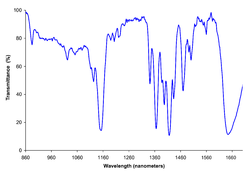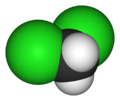This is an old revision of this page, as edited by Beetstra (talk | contribs) at 09:17, 21 January 2011 (Script assisted update of identifiers from ChemSpider, CommonChemistry and FDA for the Chem/Drugbox validation project - Updated: ChEMBL KEGG.). The present address (URL) is a permanent link to this revision, which may differ significantly from the current revision.
Revision as of 09:17, 21 January 2011 by Beetstra (talk | contribs) (Script assisted update of identifiers from ChemSpider, CommonChemistry and FDA for the Chem/Drugbox validation project - Updated: ChEMBL KEGG.)(diff) ← Previous revision | Latest revision (diff) | Newer revision → (diff)
| |||
| Names | |||
|---|---|---|---|
| IUPAC name Dichloromethane | |||
| Other names Methylene chloride, methylene dichloride, Solmethine, Narkotil, Solaesthin, Di-clo, Freon 30, R-30, DCM, UN 1593, MDC | |||
| Identifiers | |||
| CAS Number | |||
| 3D model (JSmol) | |||
| ChEBI | |||
| ChEMBL | |||
| ChemSpider | |||
| ECHA InfoCard | 100.000.763 | ||
| EC Number |
| ||
| KEGG | |||
| PubChem CID | |||
| RTECS number |
| ||
| UNII | |||
| CompTox Dashboard (EPA) | |||
InChI
| |||
SMILES
| |||
| Properties | |||
| Chemical formula | CH2Cl2 | ||
| Molar mass | 84.93 g/mol | ||
| Appearance | Colorless liquid | ||
| Density | 1.33 g/cm, liquid | ||
| Melting point | −96.7 °C (−142.1 °F; 176.5 K) | ||
| Boiling point | 39.6 °C (103.3 °F; 312.8 K) | ||
| Solubility in water | 13 g/L at 20 °C | ||
| Vapor pressure | 47 kPa at 20 °C | ||
| Hazards | |||
| Occupational safety and health (OHS/OSH): | |||
| Main hazards | Harmful (Xn), Carc. Cat. 2B | ||
| NFPA 704 (fire diamond) |
 | ||
| Flash point | None | ||
| Supplementary data page | |||
| Dichloromethane (data page) | |||
| Except where otherwise noted, data are given for materials in their standard state (at 25 °C , 100 kPa).
| |||

Dichloromethane (DCM or methylene chloride) is an organic compound with the formula CH2Cl2. This colorless, volatile liquid with a moderately sweet aroma is widely used as a solvent. More than 500,000 tons were produced in 1991. Although it is not miscible with water, it is miscible with many organic solvents. It was first prepared in 1840 by the French chemist Henri Victor Regnault, who isolated it from a mixture of chloromethane and chlorine that had been exposed to sunlight.
Production
Dichloromethane is produced by treating either methyl chloride or methane with chlorine gas at 400–500 °C. At these temperatures, both methane and methyl chloride undergo a series of reactions producing progressively more chlorinated products.
- CH4 + Cl2 → CH3Cl + HCl
- CH3Cl + Cl2 → CH2Cl2 + HCl
- CH2Cl2 + Cl2 → CHCl3 + HCl
- CHCl3 + Cl2 → CCl4 + HCl
The output of these processes is a mixture of methyl chloride, dichloromethane, chloroform, and carbon tetrachloride. These compounds are separated by distillation.
Uses
Dichloromethane's volatility and ability to dissolve a wide range of organic compounds makes it a useful solvent for many chemical processes. Concerns about its health effects have led to a search for alternatives in many of these applications.
It is widely used as a paint stripper and a degreaser. In the food industry, it has been used to decaffeinate coffee and tea as well as to prepare extracts of hops and other flavorings. Its volatility has led to its use as an aerosol spray propellant and as a blowing agent for polyurethane foams.
Specialized uses
Dichloromethane chemically welds certain plastics; for example, it is used to seal the casing of electric meters. Often sold as a main component of plastic welding adhesives, it is also used extensively by model building hobbyists for joining plastic components together — it is commonly referred to as "Di-clo."
It is also used in the garment printing industry for removal of heat-sealed garment transfers, and its volatility is exploited in novelty items — drinking birds, bubble lights, and jukebox displays.
Dichloromethane is used within the material testing field of civil engineering; specifically it is used during the testing of bituminous materials as a solvent to separate the binder from the aggregate of an asphalt or macadam to allow the testing of the materials.
Toxicity
Dichloromethane is the least toxic of the simple chlorohydrocarbons, but it is not without its health risks as its high volatility makes it an acute inhalation hazard. Dichloromethane is also metabolized by the body to carbon monoxide potentially leading to carbon monoxide poisoning. Acute exposure by inhalation has resulted in optic neuropathy and hepatitis. Prolonged skin contact can result in the dichloromethane dissolving some of the fatty tissues in skin, resulting in skin irritation or chemical burns.
It may be carcinogenic, as it has been linked to cancer of the lungs, liver, and pancreas in laboratory animals. Dichloromethane crosses the placenta. Fetal toxicity in women who are exposed to it during pregnancy, however, has not been proven. In animal experiments, it was fetotoxic at doses that were maternally toxic but no teratogenic effects were seen.
In many countries, products containing dichloromethane must carry labels warning of its health risks.
In the European Union, the European Parliament voted in 2009 to ban the use of dichloromethane in paint-strippers for consumers and many professionals. The ban took effect in December 2010.
References
- ^ M. Rossberg et al. “Chlorinated Hydrocarbons” in Ullmann’s Encyclopedia of Industrial Chemistry 2006, Wiley-VCH, Weinheim. doi:10.1002/14356007.a06_233.pub2
- Office of Environmental Health Hazard Assessment (2000). "Dichloromethane" (PDF). Public Health Goals for Chemicals in Drinking Water. California Environmental Protection Agency.
{{cite web}}: Unknown parameter|month=ignored (help) - Shell Bitumen (2003-09-25). The Shell Bitumen Handbook. ISBN 9780727732200.
- Rioux JP, Myers RA (1988). "Methylene chloride poisoning: a paradigmatic review". J Emerg Med. 6 (3): 227–238. doi:10.1016/0736-4679(88)90330-7. PMID 3049777.
- Fagin J, Bradley J, Williams D (1980). "Carbon monoxide poisoning secondary to inhaling methylene chloride". Br Med J. 281 (6253): 1461. doi:10.1136/bmj.281.6253.1461. PMC 1714874. PMID 7437838.
{{cite journal}}: CS1 maint: multiple names: authors list (link) - Kobayashi A, Ando A, Tagami N, Kitagawa M, Kawai E, Akioka M, Arai E, Nakatani T, Nakano S, Matsui Y, Matsumura M (2008). "Severe optic neuropathy caused by dichloromethane inhalation". J Ocul Pharmacol and Ther. 24 (6): 607–612. doi:10.1089/jop.2007.0100. PMID 19049266.
{{cite journal}}: CS1 maint: multiple names: authors list (link) - Cordes DH, Brown WD, Quinn KM (1988). "Chemically induced hepatitis after inhaling organic solvents". West J Med. 148 (4): 458–460. PMC 1026148. PMID 3388849.
{{cite journal}}: CS1 maint: multiple names: authors list (link) - Wells G, Waldron H (1984). "Methylene chloride burns". Br J Ind Med. 41 (3): 420. PMC 1009322. PMID 6743591.
- ^ USDHHS. "Toxicological Profile for Methylene Chloride" (PDF). Retrieved 2006-09-10.
- Bell B, Franks P, Hildreth N, Melius J (1991). "Methylene chloride exposure and birthweight in Monroe County, New York". Environ Res. 55 (1): 31–9. doi:10.1016/S0013-9351(05)80138-0. PMID 1855488.
{{cite journal}}: CS1 maint: multiple names: authors list (link) - "Dichloromethane to be banned in paint-strippers". 2009-01-14. Retrieved 2009-01-15.
External links
- International Chemical Safety Card 0058
- NIOSH Pocket Guide to Chemical Hazards. "#0414". National Institute for Occupational Safety and Health (NIOSH).
- National Pollutant Inventory - Dichloromethane Fact Sheet
- MSDS at Oxford University
- Dichloromethane at National Toxicology Program
- IARC Summaries & Evaluations Vol. 71 (1999)
- Canadian Environmental Protection Act Priority Substances List Assessment Report
| Halomethanes | |
|---|---|
| Unsubstituted | |
| Monosubstituted | |
| Disubstituted | |
| Trisubstituted | |
| Tetrasubstituted | |
| * Chiral compound. | |

